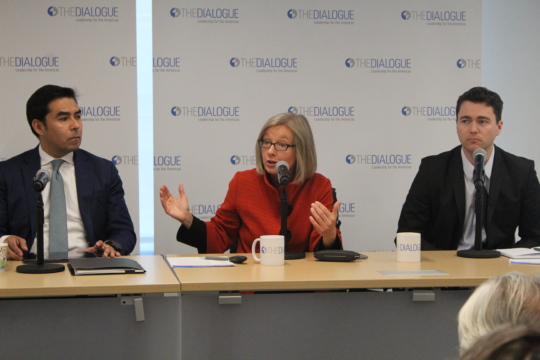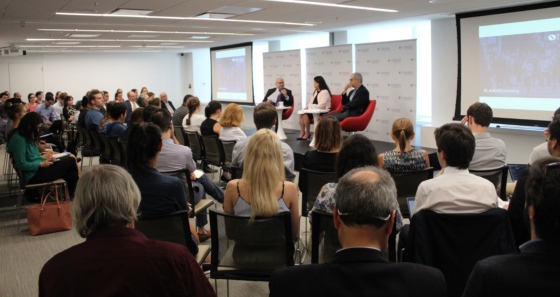
What the Brexit Means for Latin America
Latin Americans should pay close and cautious attention to the Brexit. They are not immune to the fallout.
A Daily Publication of The Dialogue
Q: After expanding by more than 50 percent over the last decade, the growth of the middle class in Latin America is slowing down, which will affect the growth rate of economies in the region, and especially certain industries such as retailers, auto manufacturers and homebuilders, according to a recent report by Moody's. The report added that economic growth in most countries of the region in 2015 will be driven by public spending and investment rather than consumer spending. Why has growth of the region's middle class slowed down, and how is Latin America's middle class faring? What needs to be done to maintain the gains of the last decade?
A: George Gray Molina, chief economist of the Regional Bureau for Latin America and the Caribbean at the United Nations Development Programme (UNDP): "Our data show two things happening simultaneously: while the rate of economic growth slows, the rate of middle-class expansion through improvements in labor income also slows--putting additional pressure on social protection programs financed by fiscal effort. At the same time, fiscal effort weakens because most Latin American tax sources (indirect taxes and natural resource taxes) are elastic to downturns in economic growth. A fork in the road opens at this point: some countries will reduce labor unit cost to spur growth in their economies, others expand social protection programs to protect workers losing jobs. An intermediate option is to accommodate external shocks through a weakening of the exchange rate (that boosts the export sector) and taking liquidity out of the financial system to slow inflationary pressures (thus reducing domestic demand). This is, in fact, already happening in some countries. Middle classes are especially vulnerable to slowdowns in growth because of their source of income-labor markets, rather than commodity or financial markets. Most vulnerable non-poor are also vulnerable for an additional reason: besides depending on labor income, their assets (financial/housing) are not yet as strong as the middle class' are. That 37 percent of the population--close to 200 million--is vulnerable to slip back into poverty."
A: John Price, managing director of Americas Market Intelligence: "Favorable demographics explain much of Latin America's middle class expansion. In only 30 years (twice as fast at the United States), fertility rates have dropped from four children per mother to two, freeing time for women to augment their income. Beyond demographics, it is useful to contrast the paths of Brazil and Mexico. The commodity boom helped inject unprecedented billions into Brazil's economy. The Workers' Party (PT) engineered a policy of direct transfers to underprivileged young mothers as a reward for keeping their children in school. That stipend lifted millions out of poverty. Cheap credit created a consumption boom from 2006 to 2012, and millions of Brazilians found employment in the retail and food service sectors. But by failing to invest sufficiently in education, infrastructure and technology adoption, Brazilian productivity gains have been mediocre. With the boom cycle now over and poor infrastructure still the norm, Brazilian real wages will drop over the next 24 months, and the middle class will shrink. In Mexico, the middle class grew slowly over the last decade, due to underinvestment, and without the same natural resource boost enjoyed in South America. However, the new reforms in power generation, telecommunications, education and financial services will attract record investment in the very sectors that most impact productivity. Five years from now, Mexico will have cheaper power, faster Internet, better access to credit and improved teachers. Then the middle class will really take off, leaving Brazil far behind."
A: Jeff Dayton-Johnson, interim dean of the Graduate School of International Policy & Management and associate professor of development practice and policy at the Monterey Institute of International Studies: "Different people mean different things when they say middle class. Some observers, for example, refer to those in the middle of the income distribution; call this 'Middle Class A.' Many people in Middle Class A have incomes below the U.S. poverty line, though they're not poor by local standards. Indeed, more than half of working people in Latin America's Middle Class A have informal-sector jobs, according to an OECD report. Growth of Middle Class A means that millions of Latin Americans have risen out of poverty in the last decade. More subtly, it means that many Latin American economies have become less unequal. Then there's Middle Class B. These are Latin Americans who can match the consumption patterns of the middle class in rich countries like the United States (and likely the group that Moody's worries about): say, people with daily incomes between $10 and $100, as a Brookings report defined the group. Middle Class B is not in the middle at all: they are crowded at the high end of the income distribution. But if even a small share of Latin America's 600 million people spend at this elevated level, they can potentially serve as a powerful domestic motor for economic growth. Both middle classes are threatened: the first by its vulnerability, the second by slow growth prospects. More robust social-protection and social-insurance policies, one the one hand, and economic reforms to bolster productivity and competitiveness, on the other, will help protect the fortunes of Latin America's dual middle class."
Latin Americans should pay close and cautious attention to the Brexit. They are not immune to the fallout.
How has the region’s middle class changed in recent years, and could new approaches help create a larger pool of upwardly mobile consumers?
On July 22, the Dialogue hosted the event “Confronting Latin America’s Economic Challenges: What Can the Region Do?” with Joyce Chang, the Chair of Global Research at JP Morgan, and Santiago Levy, a nonresident fellow with the Global Economy and Development Program at Brookings and president of the Latin American & Caribbean Economic Association.
 Diego Torres Silvestre / CC BY 2.0
Diego Torres Silvestre / CC BY 2.0

